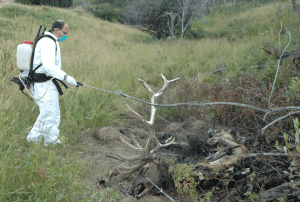Share this article
JWM study: Elk habitat overlaps with likely anthrax outbreaks
Anthrax, a deadly spore-forming bacterial disease, has been around for quite some time. In fact, it’s one of the first diseases that a vaccine was developed for in the 1930s.
However, the disease, which has been present in North America for at least 200 years, still affects wildlife and livestock species. Specifically, in 2008 in southwestern Montana, there was an anthrax outbreak in bison and elk after at least 50 years of no reported outbreaks in the area.
In a recent study published in The Journal of Wildlife Management, researchers studied where bull elk habitat and movement patterns in southwestern Montana overlap with areas where the bacteria that causes anthrax, Bacillus anthracis, could persist in the soil. This is one of four studies led by senior author Jason Blackburn, an associate professor in the Department of Geography at the University of Florida and TWS member, to better understand the disease in the herd.
“We need to be better at defining surveillance areas,” Blackburn said. “Anthrax hasn’t been a part of surveillance in the region since it hasn’t been reported there in a long time. Essentially, we’ve stopped looking for it.”

Blackburn decontaminates an elk carcass that died of anthrax in 2008. A high concentration bleach solution is used to kill Bacillus anthracis that may be on the bones and hide of the carcass. ©UF SEER Lab
As part of the study, Blackburn and his team collaborated with Montana Fish Wildlife and Parks, to collar and monitor elk during the summer months (June-August), when an anthrax outbreak is most likely to occur in North America. After receiving GPS data on where individual elk were every 30 minutes, they predicted where they’re most likely to be found in this region of southwest Montana surrounding the property affected in 2008. Then, they created a model of the potential geographic distribution of Bacillus anthracis to estimate anthrax risk in the same region.
“We found extensive overlap of high probability elk habitat and regions that could support the pathogen,” said Lillian Morris, a doctoral student in the Spatial Epidemiology and Ecology Laboratory at the University of Florida and the first author in the study. “Those areas include public, state and federal lands.”
As a result, Morris recommends that management be a collaborative effort. “The pathogen can continue to circulate if all stakeholders aren’t involved in the decontamination of carcasses and appropriate surveillance efforts,” she said. Morris said it’s hard to find elk carcasses in a densely forested area in order to determine if they’re contaminated with anthrax. “We hope that the maps we generated in this study can be used by managers in the region to know where to go out and look for carcasses,” she said. “These are the high risk areas. This is where you should prioritize resources for surveillance.” The team is continuing to research the issue and plans to study anthrax in cow elk as well.
“In the future, we will create mathematical models using these movement studies as inputs to understand the likelihood and severity of future outbreaks and understand ecological conditions to estimate the intensity and timing of anthrax outbreaks, so we will know where and when to stage intervention,” Blackburn said. “That’s the larger study’s ultimate goal.”
This study is part of an ongoing grant that the National Science Foundation and National Institute of Health Ecology and Evolution of Infectious Diseases program jointly funded to examine the ecology of the disease in Montana and Namibia, where the anthrax bacterium is widespread.
Another Elk Disease on the Decline
Meanwhile, a recent report from Wyoming Game and Fish Department shows that in 2015 there was a decline in brucellosis — another bacterial disease that affects elk. Still, recent testing showed that two cow elk in the Bighorn Mountains have tested positive for the disease, making it the fourth year in a row that elk from that area have tested positive for brucellosis.
The Department plans to continue to monitor the elk herds and work with hunters to collect blood samples from elk that they harvest.
Header Image: A group of bull elk move across a landscape that could support Bacillus anthracis. ©Jason Blackburn








